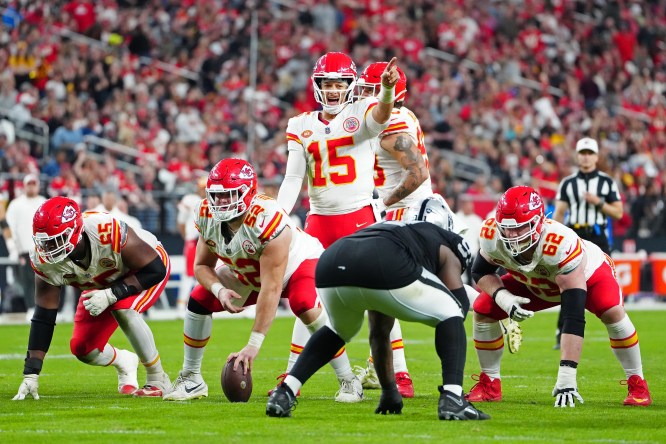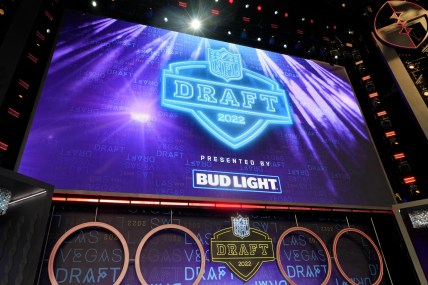The Kansas City Chiefs entered the 2023 season viewed as the NFL’s newest dynasty. Led by Patrick Mahomes, Andy Reid and Travis Kelce, the Chiefs already won two Super Bowls and they had a legitimate shot at hoisting the Lombardi Trophy for the third time with this group. Now, all of that is in doubt.
Reactions to the Week 14 loss to the Buffalo Bills aren’t overhyping a small sample size and Mahomes’ response has very little to do with the calls made on the field. Instead, the Chiefs’ on-field struggles and Mahomes’ unprecedented loss of composure can be traced to the team’s biggest problem. Unfortunately for Kansas City, the problem has only gotten worse throughout the season and as pressure steadily built on this top-heavy team, cracks are starting to show.
Related: NFL GM believes Kansas City Chiefs star Travis Kelce is ‘almost done’ as an impact player
Let’s examine the issues that have led to the Chiefs going from Super Bowl champions to a team many now believe might not even win multiple playoff games.
Examining the impact of the Kansas City Chiefs receiving corps on Patrick Mahomes

A year after trading away Tyreek Hill because general manager Brett Veach determined he didn’t want to invest that much in a wide receiver, Kansas City let JuJu Smith-Schuster walk in NFL free agency. Parting ways with him wasn’t necessarily the wrong decision, but the flaw in the process was what came after.
Veach and the Chiefs’ coaching staff essentially decided to bank on player development. Skyy Moore and Kadarius Toney would need to evolve into something they’ve never been before, wide receivers who can create throwing lanes on their own without the scheme opening things up for them. Without that, Kansas City would have a volatile deep threat with bad hands (Marquez Valdes-Scantling), a depth receiver (Justin Watson) and two gadget pieces (Moore and Toney) along with rookie Rashee Rice.
DeAndre Hopkins, Jerry Jeudy, Courtland Sutton and Odell Beckham Jr. were all available during the offseason, but Kansas City passed on them. When it became clear after September that the Chiefs’ receiving corps could cost them more games, trading for a reliable offensive weapon could’ve been explored. Instead, Kansas City stood pat. Veach and Reid wanted Mahomes to make the most out of what he had, this is what he has.
Kansas City Chiefs receivers
| Player | Target Separation | Contested Catch Rate | True Catch Rate | Route Win Rate |
| Marquez Valdes-Scantling | 1.85 yards (26th) | 20% (91st) | 81% (94th) | 40.5% (89th) |
| Justin Watson | 1.36 (78th) | 60% (8th) | 76.9% (96th) | 43.3% (65th) |
| Skyy Moore | 2.11 (14th) | 14.3% (97th) | 84% (84th) | 41.6% (76th) |
| Kadarius Toney | 2.57 (4th) | N/A | 84.6% (82nd) | 48.5% (37th) |
While Toney has one of the highest target separations in the NFL, it requires context. He has one of the lowest average target distances (aDOT) in the NFL at 2.9 yards, meaning he gets open near the line of scrimmage and that’s it.
Now we’ll address the drops. Everyone knows the Chiefs lead the NFL in drops this season, but it’s worth examining just how often it happens. Kansas City’s wide receivers have dropped 8 percent of Mahomes’ passes this season, per ESPN’s Bill Barnwell, the highest mark in the NFL over the last decade.
Related: NFL power rankings
So, Mahomes is asked to stand behind the pocket and make a difficult decision in split seconds. If his two trusted receiving options (Kelce and Rice) are covered, he needs to buy additional time for wide receivers who’ve proven they can’t get open on their own. Even when extending the play, those pass-catchers have demonstrated they might not be in the right spot (multiple instances) or they drop it (league-high drop rate). It’s a no-win scenario for a quarterback and it helps explain some of the issues versus pressure in 2023.
Patrick Mahomes’ unusual issues versus pressure
| QB Rating | TD % – INT % | ||
| Patrick Mahomes vs pressure (’22) | 77.8 | 6.1% – 3.1% | |
| Patrick Mahomes vs pressure (’23) | 58.9 | 2% – 4.6% | |
| Patrick Mahomes vs blitz (’22) | 108.9 | 8.7% – 0.8% | |
| Patrick Mahomes vs blitz (’23) | 98.0 | 4.6% – 1.5% |
There’s another problem now, too. If Mahomes was playing behind the best offensive line in the NFL, they would give him more than 2.5 seconds in the pocket to throw and starting-caliber receivers can typically get open after 2.5 seconds. Unfortunately for Mahomes, the Chiefs’ offensive line also isn’t as effective as before.
- Weeks 1-7: 86.2 Pass Blocking Efficiency, 79 pressures and 57 hurries allowed on 300 dropbacks
- Weeks 8-14: 83.3 Pass Blocking Efficiency, 76 pressures and 58 hurries allowed on 251 dropbacks
Trust in wide receivers also ties into situations. On critical third-down situations or in potential game-winning drives late in the game, quarterbacks tend to rely on the pass-catchers they know they can depend on. It becomes instinctual, with every second counting the players who you know can either make a play or just get open become the go-to option because their quarterback doesn’t have to keep buying precious time with his legs or force the ball in. Mahomes clearly doesn’t have that comfort with Valdes-Scantling, Moore, Toney and Watson, nor should he. Unfortunately, that’s also affecting Kansas City situationally.
- Patrick Mahomes in 4th quarter (2022): 87.7 QB rating, 6-6 TD-INT, 66.1% completion, 7.08 ay/a
- Patrick Mahomes in 4th quarter (2023): 68.8 QB rating, 3-2 TD-INT, 52.2% completion, 4.97 ay/a
- Kansas City Chiefs red-zone offense (’22): 71.08% TD rate, 4.2 RZ attempts per game
- Kansas City Chiefs red-zone offense (2023): 56.25% TD rate, 3.7 RZ attempts per game
Defenses recognize that Kelce is regressing with age, becoming less explosive of an offensive weapon, and RIce is going through the same ups and downs as every rookie receiver does. After the Chiefs started 6-1, opponents adjusted and exploited Kansas City’s weaknesses. More than that, though, we’re seeing a team whose defense is no longer able to as consistently erase the mistakes its offense is making.
Related: NFL Expert Picks
The Kansas City Chiefs defense can no longer put the team on its back

The Kansas City Chiefs defense showed small glimpses in the season-opener of becoming a top-10 unit. It didn’t take long after the return of All-Pro defensive tackle Chris Jones before this became one of the best defenses in football. Kansas City’s defense was playing at such a high level that it distracted from issues on the other side of the ball.
Unfortunately, that distraction is gone. Not only has the spotlight been put on a sluggish Chiefs’ offense, but the vaunted Kansas City defense is also regressing in the second half of the season.
| QB Rating | YPA | Completion % | TD% – INT% | Sacks per Game | 3rd Down Conversion | |
| KC Chiefs defense (Weeks 2-7) | 77.9 | 5.9 | 59.9 | 3.5% (7) – 2.5% (5) | 3.5 | 37.8% |
| KC Chiefs defense (Weeks 8-14) | 93.1 | 6.4 | 63.1 | 4.8% (9) – 1.1% (2) | 3.3 | 39.5% |
If you exclude Week 8 (Denver Broncos), that eliminates six sacks from the Chiefs’ totals and their average drops to 2.8 sacks per game. More alarming, they’ve averaged just 2 sacks per contest over the last three weeks.
Kansas City isn’t anything close to being a bottom-10 pass defense, it’s still surrendering just 1.2 touchdowns and 199.2 passing yards per game with an 88.7 QB rating over the last five weeks. However, even slight regression means the defense spends more time on the field, gives up more points and the offense has longer drive distances to cover. The real problem is the inability to stop the run.
This has been a problem all year that’s only getting worse. In the first five weeks of the season, opponents averaged just 97.2 rushing yards per game versus Kansas City, but they did manage a solid 4.3 yards per carry average. Still, Kansas City never allowed more than 118 total rushing yards in a single game.
Related: Highest-paid NFL players
Since Week 6, every Chiefs’ opponent has rushed for at least 114 yards. Over that eight-game span, Kansas City has ceded 1,008 rushing yards (126 rush ypg), 4.7 yards per carry and 7 rushing touchdowns. For context, only four NFL teams (DEN, NYG, CIN, BUF) have allowed 4.7-plus ypc this season and three of them (Denver, Cincinnati, Buffalo) have reversed their fortunes over the last month.
At the very least, the Chiefs’ defense can no longer carry them in big games against great offenses. In a highly competitive playoff field, with no signs of improvement from the Chiefs’ receiving corps, that could lead to a first-round exit if Kansas City draws specific opponents. If a first-round knockout for the defending Super Bowl champions isn’t bad enough, fans might want to start preparing for what will likely happen to this unit in 2024 if Chris Jones departs in NFL free agency.




